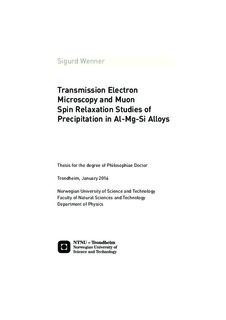| dc.contributor.advisor | Holmestad, Randi | nb_NO |
| dc.contributor.author | Wenner, Sigurd | nb_NO |
| dc.date.accessioned | 2014-12-19T13:19:15Z | |
| dc.date.available | 2014-12-19T13:19:15Z | |
| dc.date.created | 2013-12-30 | nb_NO |
| dc.date.issued | 2014 | nb_NO |
| dc.identifier | 682835 | nb_NO |
| dc.identifier.isbn | 978-82-471-4891-4 | nb_NO |
| dc.identifier.uri | http://hdl.handle.net/11250/247164 | |
| dc.description.abstract | The Al–Mg–Si system is a heat-treatable class of aluminium alloys that gain their mechanical strength via precipitation hardening. The main hardening phases are precipitated as needle-shaped nano-sized particles from a solid solution of Mg, Si and other added elements. Transmission electron microscopy and muon spin relaxation was used to study precipitation and clustering in Al–Mg–Si alloys, varying the heat treatment and chemical composition in order to understand the kinetics of precipitation and the morphology, distribution, and atomic structure of hardening precipitates.
Muons were found to form bonds with vacancies, atoms in solid solution, and clusters of solute atoms, which are the defects we can gain information from by applying muon spin relaxation to Al alloys. In binary Al–Mg and Al–Si alloys, we discovered very different vacancy behaviours after cooling from high temperatures: Si–vacancy clusters are quickly formed at room temperature in Al–Si, while Al–Mg keeps a much higher vacancy content than pure Al and Al–Si despite a lack of solute clustering. A high muon trapping in a specific temperature range was found in a 1.6% Mg2Si alloy annealed for 16 hours at 70–150 °C. These conditions contain clusters and Guinier–Preston-zones preceding the main hardening phase beta'' in the precipitation sequence. Density functional theory calculations support that the relevant muon trapping site is vacancies inside these structures, suggesting that the structures are stabilised by absorbing vacancies during annealing.
The roles of the elements Cu and Ca on precipitation during artificial ageing were investigated. Room temperature storage gives a negative effect on the strength of aged high-solute Al–Mg–Si alloys, in particular when the Mg/Si ratio is high. The negative effect was found to be diminished and delayed by adding 0.14 at.% Cu to alloys with Mg+Si = 1.3 at.%, in addition to giving an overall strength increase. Transmission electron microscopy investigations revealed that the fraction of Cu-containing precipitates increased with room temperature storage before ageing. The Cu addition is believed to help the formation of clusters that can act as nucleation sites for hardening precipitates and/or prevent the formation of clusters that can not. Various amounts of Ca was added to an alloy with 0.53% Mg and 0.40% Si. The Ca accumulated in large particles with composition CaAl2Si2, as determined by X-ray energy dispersive spectroscopy. The presence of Si in the particles causes a reduction of the available Si for precipitation and an increase in the effective Mg/Si ratio. The result is a coarser microstructure with a higher fraction of over-aged precipitates and a lower mechanical strength.
Aberration-corrected scanning transmission electron microscopy coupled with electron energy loss spectroscopy was conducted on an over-aged Al–Mg–Si–Cu–Ag alloy. The microstructure consisted of mostly disordered L and Q' precipitates. After applying principal component analysis to the acquired spectrum images, atomic columns containing Cu and Ag could be clearly distinguished. Cu and Ag were seen to prefer different atomic configurations, and were not observed occupying the same columns. While Cu columns mostly resided in ordered parts of precipitates and along precipitate–matrix interfaces, Ag was diluted in several nearby columns in disordered parts, and at precipitate–matrix interfaces of high misfit. | nb_NO |
| dc.language | eng | nb_NO |
| dc.publisher | NTNU | nb_NO |
| dc.relation.ispartofseries | Doktoravhandlinger ved NTNU, 1503-8181; 2014:1 | nb_NO |
| dc.relation.haspart | Wenner, Sigurd; Holmestad, Randi; Matsuda, Kenji; Nishimura, Katsuhiko; Matsuzaki, Teiichiro; Tomono, Dai; Pratt, Francis L.; Marioara, Calin D.. Probing defects in Al-Mg-Si alloys using muon spin relaxation. Physical Review B Condensed Matter. (ISSN 0163-1829). 86(104201), 2012. <a href='http://dx.doi.org/10.1103/PhysRevB.86.104201'>10.1103/PhysRevB.86.104201</a>. | nb_NO |
| dc.relation.haspart | Wenner, Sigurd; Nishimura, Katsuhiko; Matsuda, Kenji; Matsuzaki, Teiichiro; Tomono, Dai; Pratt, Francis L.; Marioara, Calin D.; Holmestad, Randi. Muon kinetics in heat treated Al (–Mg)(–Si) alloys. Acta Materialia. (ISSN 1359-6454). 61(16): 6082-6092, 2013. <a href='http://dx.doi.org/10.1016/j.actamat.2013.06.050'>10.1016/j.actamat.2013.06.050</a>. | nb_NO |
| dc.relation.haspart | Wenner, S.; Marioara, C. D.; Andersen, S. J.; Holmestad, R.. Effect of room temperature storage time on precipitation in Al–Mg–Si(–Cu) alloys with different Mg/Si ratio. International Journal of Materials Research - Zeitschrift für Metallkunde. (ISSN 1862-5282). 103: 948-954, 2012. <a href='http://dx.doi.org/10.3139/146.110795'>10.3139/146.110795</a>. | nb_NO |
| dc.relation.haspart | Wenner, Sigurd; Marioara, Calin D.; Andersen, Sigmund J.; Holmestad, Randi. How calcium prevents precipitation hardening in Al–Mg–Si alloys. Materials Science & Engineering - A. (ISSN 0921-5093). 575(0): 241-247, 2013. <a href='http://dx.doi.org/10.1016/j.msea.2013.03.067'>10.1016/j.msea.2013.03.067</a>. | nb_NO |
| dc.relation.haspart | Wenner, Sigurd; Marioara, Calin D.; Ramasse, Quentin M.; Kepaptsoglou, Despoina-Maria; Hage, Fredrik S.; Holmestad, Randi. Atomic-resolution electron energy loss studies of precipitates in an Al–Mg–Si–Cu–Ag alloy. Scripta Materialia. (ISSN 1359-6462). 74(0): 92-95, 2014. <a href='http://dx.doi.org/10.1016/j.scriptamat.2013.11.007'>10.1016/j.scriptamat.2013.11.007</a>. | nb_NO |
| dc.title | Transmission electron microscopy and muon spin relaxation studies of precipitation in Al–Mg–Si alloys | nb_NO |
| dc.type | Doctoral thesis | nb_NO |
| dc.source.pagenumber | 132 | nb_NO |
| dc.contributor.department | Norges teknisk-naturvitenskapelige universitet, Fakultet for naturvitenskap og teknologi, Institutt for fysikk | nb_NO |
| dc.description.degree | PhD i fysikk | nb_NO |
| dc.description.degree | PhD in Physics | en_GB |


